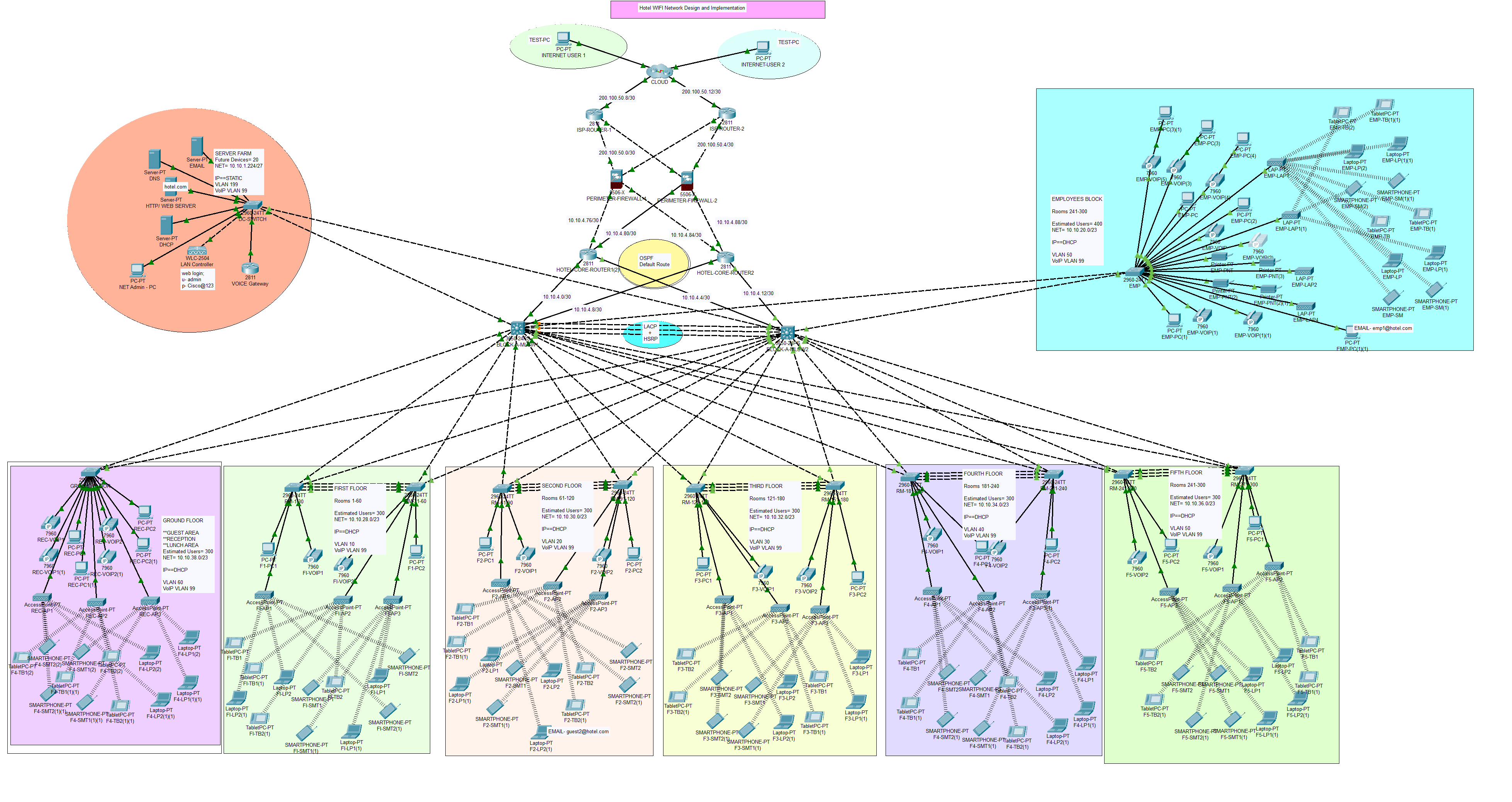Secure Hotel WLAN Network System Design and Implementation
Scenario Description: Secure Hotel WLAN Network:
The hotel envisions a comprehensive network infrastructure to support its operations and provide seamless connectivity for guests and employees. The hotel consists of two main blocks: a guest block with five floors hosting approximately 300 guest rooms and common areas, and an employee block for approximately 300 staff members. The guest block is expected to accommodate up to 3000 users, with the ground floor serving as a hub for reception, parking, restaurant, and guest waiting areas, hosting an additional 400 users. To support this user density, the network is segmented into three subnets: Guest (10.10.28.0/18), Employees (10.10.20.0/23), and IP Phones (172.16.10.0/16), ensuring efficient traffic management and optimal resource allocation.
The network infrastructure is designed to integrate LAN, WAN, and a server farm to ensure robust communication across all departments. The server farm hosts critical services such as DHCP, DNS, email, and VoIP servers, facilitating secure and reliable network operations. VLANs are employed to segregate traffic for guests, employees, and IP phones, enhancing both performance and security. A high-speed WAN connects the blocks, while LAN ensures efficient internal communication. The network employs firewalls and encryption protocols to secure sensitive communications, particularly between the guest block, employee block, and server farm. Access control lists (ACLs) and switch port security are also implemented to prevent unauthorized access.
To meet high availability and scalability demands, the network incorporates dynamic routing protocols such as OSPF and redundancy through HSRP to minimize downtime. Dynamic IP allocation via DHCP ensures flexibility for the growing user base, while static IPs are reserved for critical servers and devices. The design ensures that IP phones across the network can seamlessly communicate, providing reliable telephony services for both guests and staff. By integrating scalable, secure, and high-performance technologies, this network design supports the hotel's operations and enhances guest and employee experiences.
- Network Segmentation: - Guest subnet: 10.10.28.0/18
- Critical Network Components: - LAN for internal communication within each block
- Traffic Management: - VLANs to isolate traffic for guests, employees, and IP phones
- IP Management: - Dynamic IP allocation for devices via DHCP
- Network Security: - Firewalls for traffic inspection and protection
- High Availability and Redundancy: - HSRP (Hot Standby Router Protocol) to ensure continuous network operation during router failures
- Routing Protocols: - OSPF for efficient dynamic routing between blocks
- Telephony Services: - VoIP telephony configuration for seamless communication across all devices
- Scalability and Flexibility: - Designed to accommodate up to 3000 users in the guest block and 300 employees in the employee block.
- Employees subnet: 10.10.20.0/23
- IP Phones subnet: 172.16.10.0/16
- High-speed WAN to connect guest and employee blocks
- Server farm hosting DHCP, DNS, email, and VoIP servers
- Static IP assignment for critical servers and devices
- Encryption protocols to secure sensitive data transmission
- Access Control Lists (ACLs) to regulate traffic and restrict unauthorized access
- Switch port security to prevent unauthorized device connections
- Backup servers for redundancy in case of primary server failure
The network topology below satisfy the user requirements above and everything is verified, tested and working fine.
